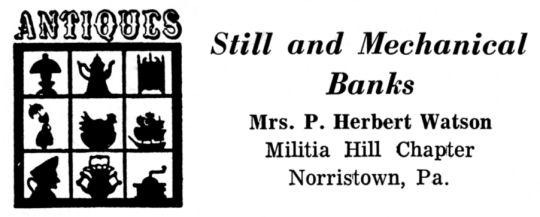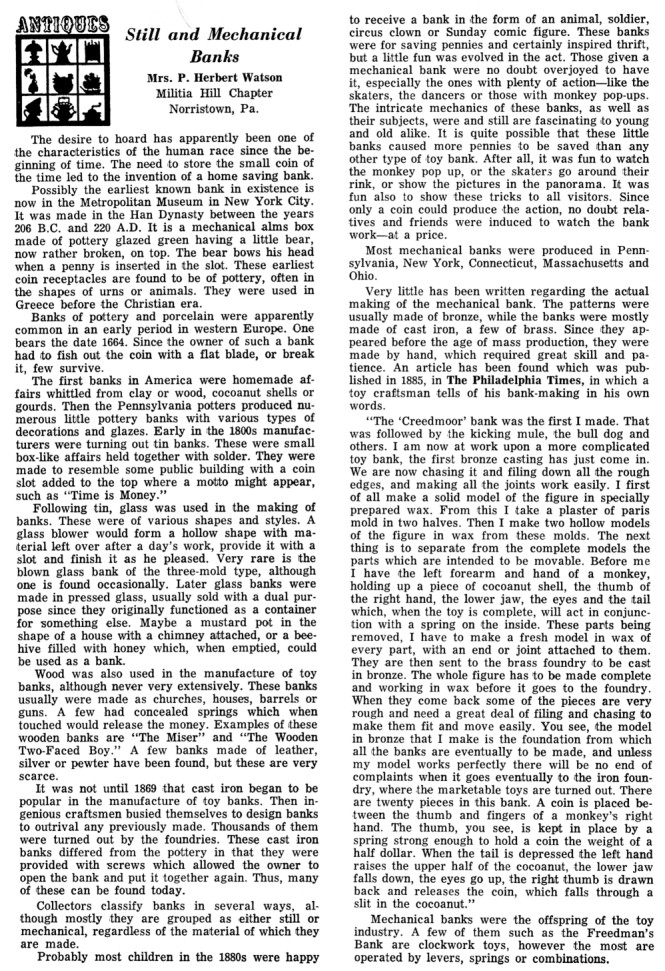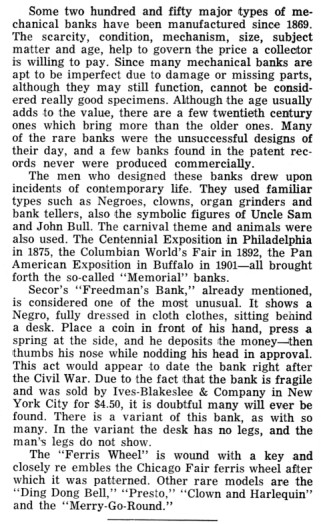|
THE QUESTERS
VOL. XVII SPRING, 1968 NO.3

Still and
Mechanical Banks
Mrs. P. Herbert Watson
Militia Hill Chapter
Norristown, Pa.
The desire to hoard has apparently been one of the characteristics
of the human race since the beginning of time. The need to store the
small coin of the time led to the invention of the home saving bank.
Possibly the earliest known bank in existence is now in the
Metropolitan Museum in New York City. It was made in the Han Dynasty
between the years 206 B.C. and 220 A.D. It is a mechanical alms box made
of pottery glazed green having a little bear, now rather broken, on top.
The bear bows his head when a penny is inserted in the slot. These
earliest coin receptacles are found to be of pottery, often in Greece
before the Christian era.
Banks of pottery and porcelain were apparently common in an early
period in western Europe. One bears the date 1664. Since the owner of
such a bank had to fish out the coin with a flat blade, or break it, few
survive.
The first banks in America were homemade affairs whittled from clay
or wood, cocoanut shells or gourds. Then the Pennsylvania potters
produced numerous little pottery banks with various types of decorations
and glazes. Early in the 1800s manufacturers were turning out tin banks.
These were small box-like affairs held together with solder. They were
made to resemble some public building with a coin slot added to the top
where a motto might appear, such as "Time is Money."
Following tin, glass was used in the making of banks. These were of
various shapes and styles. A glass blower would form a hollow shape with
material left over after a day's work, provide it with a slot and finish
it as he pleased. Very rare is the blown glass bank of the three-mold
type, although one is found occasionally. Later glass banks were made in
pressed glass, usually sold with a dual purpose since they originally
functioned as a container for something else. Maybe a mustard pot in the
shape of a house with a chimney attached, or a beehive filled with honey
which, when emptied, could be used as a bank.
Wood was also used in the manufacture of toy banks, although never
very extensively. These banks usually were made as churches, houses,
barrels or guns. A few had concealed springs which when touched would
release the money. Examples of these wooden banks are "The Miser" and
"The Wooden Two-Faced Boy." A few banks made of leather, silver or
pewter have been found, but these are very scarce.
It was not until 1869 that cast iron began to be popular in the
manufacture of toy banks. Then ingenious craftsmen busied themselves to
design banks to outrival any previously made. Thousands of them were
turned out by the foundries. These cast iron banks differed from the
pottery in that they were provided with screws which allowed the owner
to open the bank and put it together again. Thus, many of these can be
found today.
Collectors classify banks in several ways, although mostly they are
grouped as either still or mechanical, regardless of the material of
which they are made.
Probably most children in the 1880s were happy to receive a bank in
the form of an animal, soldier, circus clown or Sunday comic figure.
These banks were for saving pennies and certainly inspired thrift, but a
little fun evolved in the act. Those given a mechanical bank were no
doubt overjoyed to have it, especially the ones with plenty of action —
like the skaters, the dancers or those with monkey pop-ups. The
intricate mechanics of these banks, as well as their subjects, were and
still are fascinating to young and old alike. It is quite possible that
these little banks caused more pennies to be saved than any other type
of toy bank. After all, it was fun to watch the monkey pop up, or the
skaters go around their rink, or show the pictures in the panorama. It
was fun also to show these tricks to all visitors. Since only a coin
could produce the action, no doubt relatives and friends were induced to
watch the bank work — at a price.
Most mechanical banks were produced in Pennsylvania, New York,
Connecticut, Massachusetts and Ohio.
Very little has been written regarding the actual making of the
mechanical bank. The patterns were usually made of bronze, while the
banks were mostly made of cast iron, a few of brass. Since they appeared
before the age of mass production, they were made by hand, which
required great skill and patience. An article has been found which was
published in 1885, in
The Philadelphia Times,
in which a toy craftsman tells of his bank-making in his own words.
"The 'Creedmoor' bank was the first I made. That was followed by
the kicking mule, the bull dog and others. I am now at work upon a more
complicated toy bank, the first bronze casting has just come in. We are
now chasing it and filing down all the rough edges, and making all the
joints work easily. I first of all make a solid model of the figure in
specially prepared wax. From this I take a plaster of paris mold in two
halves. Then I make two hollow models of the figure in wax from these
molds. The next thing is to separate from the complete models the parts
which are intended to be movable. Before me I have the left forearm and
hand of a monkey, holding up a piece of cocoanut shell, the thumb of
which, when the toy is complete, will act in conjunction with a spring
on the inside. These parts being removed, I have to make a fresh model
in wax of every part, with an end or joint attached to them. They are
then sent to the brass foundry to be cast in bronze. The whole figure
has to be made complete and working in wax before it goes to the
foundry. When they come back some of the pieces are very rough and need
a great deal of filing and chasing to make them fit and move easily. You
see, the model in bronze that I make is the foundation from which all
the banks are eventually to be made, and unless my model works perfectly
there will be no end of complaints when it goes eventually to the iron
foundry, where the marketable toys are turned out. There are twenty
pieces in this bank. A coin is placed between the thumb and fingers of a
monkey's right hand. The thumb, you see, is kept in place by a spring
strong enough to hold a coin the weight of a half dollar. When the tail
is depressed the left hand raises the upper half of the cocoanut, the
lower jaw falls down, the eyes go up, the right thumb is drawn back and
releases the coin, which falls through a slit in the cocoanut."
Mechanical banks were the offspring of the toy industry. A few of
them such as the Freedman's Bank are clockwork toys, however the most
are operated by levers, springs or combinations.
Some two hundred and fifty major types of mechanical banks have
been manufactured since 1869. The scarcity, condition, mechanism, size,
subject matter and age, help to govern the price a collector is willing
to pay. Since many mechanical banks are apt to be imperfect due to
damage or missing parts, although they may still function, cannot be
considered really good specimens. Although the age usually adds to the
value, there are a few twentieth century ones which bring more than the
older ones. Many of the rare banks were the unsuccessful designs of
their day, and a few banks found in the patent records never were
produced commercially.
The men who designed these banks drew upon incidents of
contemporary life. They used familiar types such as Negroes, clowns,
organ grinders and bank tellers, also the symbolic figures of Uncle Sam
and John Bull. The carnival theme and animals were also used. The
Centennial Exposition in Philadelphia in 1875, the Columbian World's
Fair in 1892, the Pan American Exposition in Buffalo in 1901 — all
brought forth the so-called "Memorial" banks.
Secor's "Freedman's Bank," already mentioned, is considered one of
the most unusual. It shows a Negro, fully dressed in cloth clothes,
sitting behind a desk. Place a coin in front of his hand, press a spring
at the side, and he deposits the money — then thumbs his nose while
nodding his head in approval. This act would appear to date the bank
right after the Civil War. Due to the fact that the bank is fragile and
was sold by Ives-Blakeslee & Company in New York City for $4.50, it is
doubtful many will ever be found. There is a variant of this bank, as
with so many. In the variant the desk has no legs, and the man's legs do
not show.
The "Ferris Wheel" is wound with a key and closely resembles the
Chicago Fair ferris wheel after which it was patterned. Other rare
models are the "Ding Dong Bell," "Presto," "Clown and Harlequin" and the
"Merry-Go-Round."


|